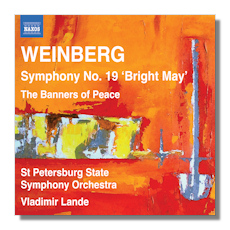
The Internet's Premier Classical Music Source
Related Links
- M. Weinberg Reviews
- Latest Reviews
- More Reviews
-
By Composer
-
Collections
DVD & Blu-ray
Books
Concert Reviews
Articles/Interviews
Software
Audio
Search Amazon
Recommended Links
Site News
 CD Review
CD Review
Mieczysław Weinberg

- Symphony #19 "Bright May"
- Symphonic Poem "The Banners of Peace"
St. Petersburg State Symphony Orchestra/Vladimir Lande
Naxos 8.572752 56m
Summary for the Busy Executive: The shadowed peace.
Born in Poland, the composer Mieczyslaw Weinberg (also known as Moishe Vainberg and variants thereof), in spite of the majority of refugees at the approach of Nazi armies, fled East to the Soviet Union, rather than West to Paris or Lisbon. Apparently, he preferred Russian anti-Semitism to German and Polish. He chose with no really good outcome available. The Nazis killed the family that remained. He met Shostakovich, who examined the score of Weinberg's Symphony #1 and recognized his talent immediately. Although influenced by Shostakovich, he never studied with him. They were more like colleagues and friends. Weinberg assumed aspects of Shostakovich's style and moreover had the talent to write as well as the older man. Indeed, many consider him the equal of Shostakovich and Prokofiev. However, Weinberg also influenced Shostakovich and got him interested in Jewish melody and string quartet writing. The two competed in a friendly way to see who could produce more string quartets. Shostakovich was one up at the time of his death.
Soviet music administrative muck-a-mucks mostly ignored Weinberg's music, but fortunately he attracted the admiration of really good Russian musicians, who performed him anyway. Nevertheless, Weinberg seldom received official commissions, and in fact, he almost "disappeared" in the anti-Semitic pograms, the so-called "doctors' plot," after World War II. Only Stalin's death saved him. The new government decreed the charges trumped-up and released both him and the doctors. He lived long enough to complete 22 symphonies, 17 string quartets, a boatload of other chamber and orchestral music, film scores, ballets, and an opera, although he never achieved economic security.
We can dispense with The Banners of Peace right away. It's the kind of thing Soviet composers turned out by the bushel for Party functions. Weinberg's score isn't any worse than the average and much better written than some, but it's capable, rather than personal.
Some of Weinberg's symphonies cluster in programmatic sets, as is the case of Symphonies 17 ("Memory"), 18 ("War – there is no word more cruel"), and 19 ("The Bright May"), designated as the "War Triptych." Symphony #19 (1985) premiered in 1986 under Vladimir Fedoseyev and the USSR Radio Symphony Orchestra. Its subtitle refers not to the standard May Day celebration, but to the end of World War II in the Soviet Union. Consequently, it doesn't hymn the Soviet ghosts on the official dais but instead meditates on the psychological complexities of the cataclysm's aftermath. More Russians died in World War II than any other nationality. Many died horribly, not just from munitions, but from disease and starvation as well. The war's end had to have been greeted with a huge national exhalation, yet with a consciousness of the huge cost. Furthermore, at the distance of four decades, Weinberg's own ambivalence toward the outcome (active anti-Semitism, repressive, corrupt serial dictatorships) also finds its way into the symphony.
A man who writes 22 symphonies either repeats himself or finds different ways to write them. Weinberg travels the second route. This is by no means a conventional symphony. Movements follow one another without pause. Its themes are really fragments, mostly re-ordered or continually varied, and most appear in all movementments. On the one hand, it resembles a fantasia. You won't find the usual exposition-development-recap here. Nevertheless, the work tightly coheres. It is both epic and personal, as if War and Peace had been written by Chekhov. One remembers it as a long, complex musical argument rather than a series of movements or even of sections. This symphony comes from a writer who has absorbed symphonic procedures to the point where he no longer has to think consciously about them – a poet of the form.
A striving, Angst-filled line begins the first movement. The theme, long and complex, breaks down into readily identifiable gestures, particularly since Weinberg repeats them throughout. As it procedes, Weinberg ratchets up tension to a point where it breaks into a calm folk-like theme. However, that theme derives from a subsidiary line from the first section. It too builds, with increasingly martial ideas based on the first theme becoming ever-more frantic. That also breaks, and we get a recapitulation of sorts of the first section, this time subdued.
The strings play a serene adagio, closer to Prokofiev's balcony scene from Romeo and Juliet than to Weinberg's usual slow music. Gradually, a rhythm, like a triple-time funeral march, emerges. Winds begin to enter, and the serenity begins to disappear. The music morphs into the militaristic, the half-celebratory, and the half-grotesque dominated by the brass which move from the heroic to the hectoring. The forces exhaust themselves, and the section becomes a tired flute and clarinet (later strings) in a spent duet.
From this emerges an elegy, not unlike Shostakovich's "song of nature" in his Symphony #13, rueful, heartbreaking, and benedictory at the same time. The horrors have happened, but the world goes on, perhaps better this time. On this, Weinberg ends.
Vladimir Lande has a firm grip on the symphony – no small feat. The orchestra plays as if the music means something to them. For me, a shattering account.
Copyright © 2018, Steve Schwartz





















